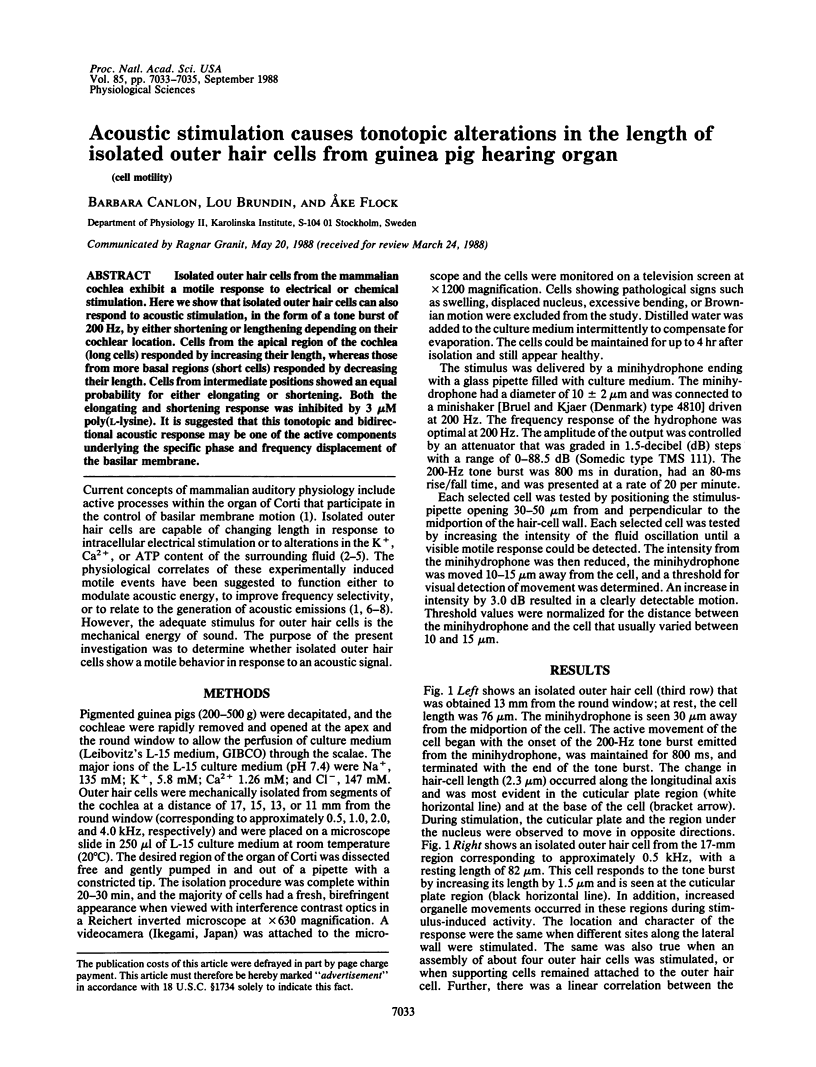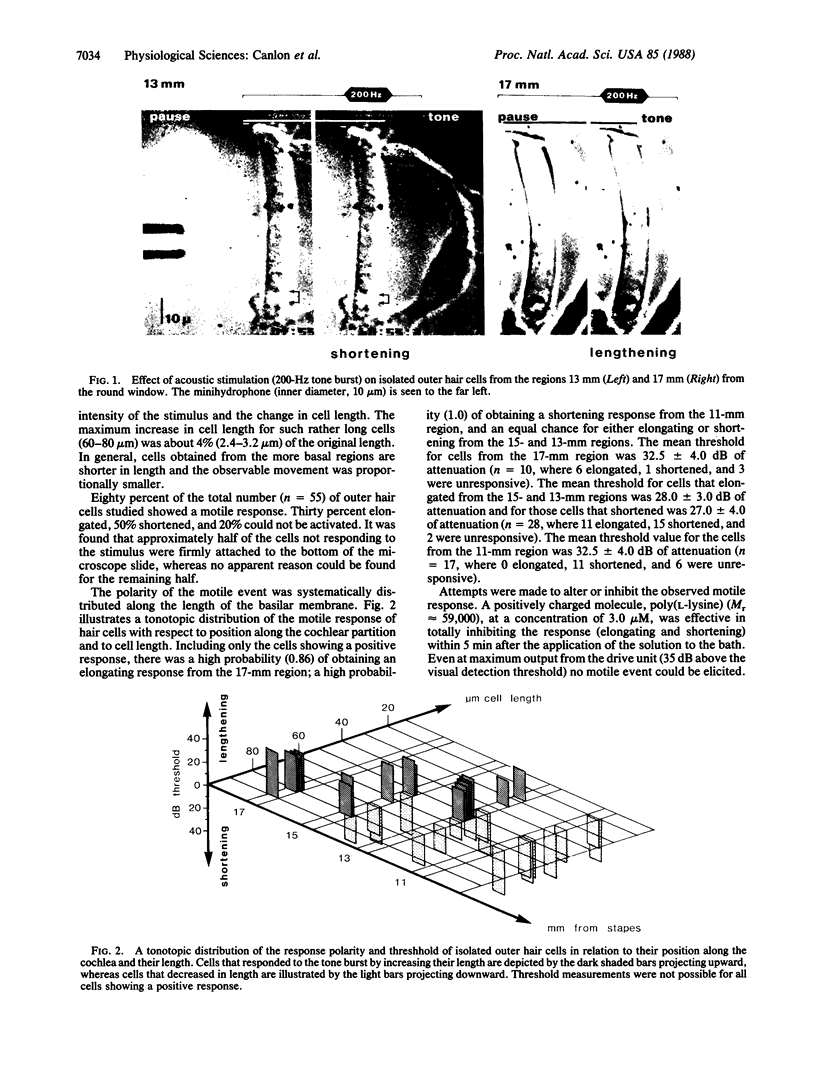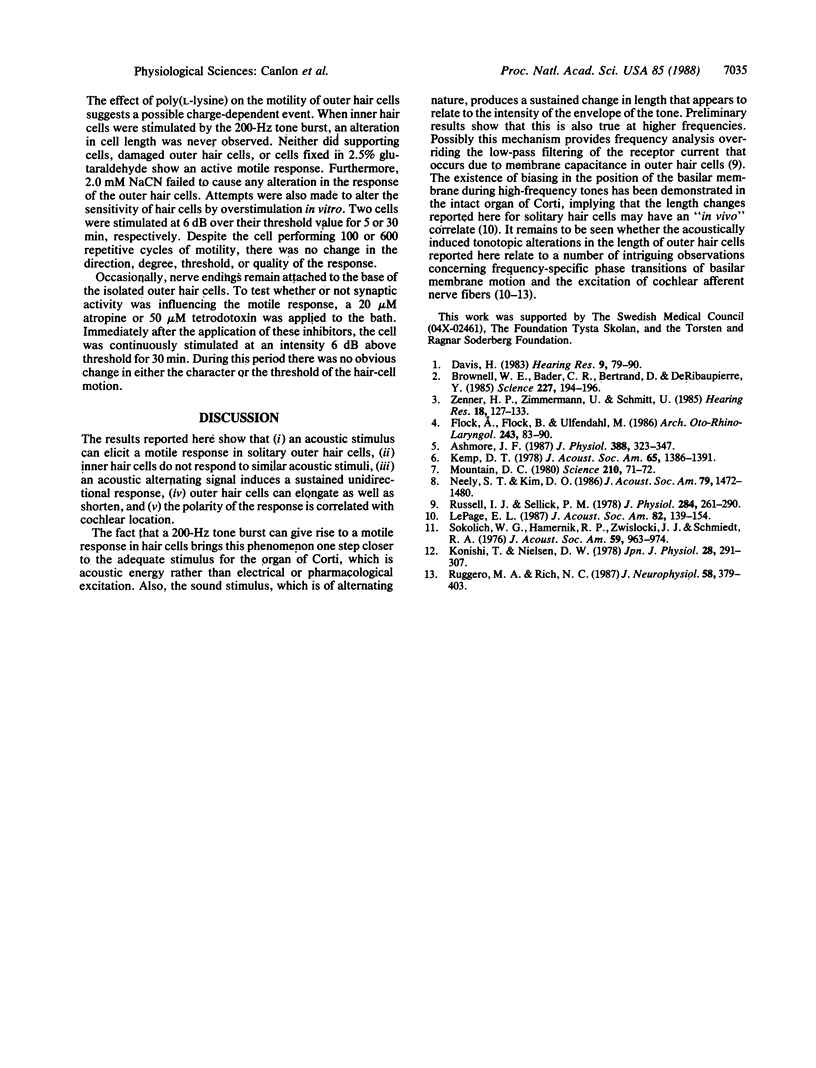Abstract
Isolated outer hair cells from the mammalian cochlea exhibit a motile response to electrical or chemical stimulation. Here we show that isolated outer hair cells can also respond to acoustic stimulation, in the form of a tone burst of 200 Hz, by either shortening or lengthening depending on their cochlear location. Cells from the apical region of the cochlea (long cells) responded by increasing their length, whereas those from more basal regions (short cells) responded by decreasing their length. Cells from intermediate positions showed an equal probability for either elongating or shortening. Both the elongating and shortening response was inhibited by 3 microM poly(L-lysine). It is suggested that this tonotopic and bidirectional acoustic response may be one of the active components underlying the specific phase and frequency displacement of the basilar membrane.
Full text
PDF


Images in this article
Selected References
These references are in PubMed. This may not be the complete list of references from this article.
- Ashmore J. F. A fast motile response in guinea-pig outer hair cells: the cellular basis of the cochlear amplifier. J Physiol. 1987 Jul;388:323–347. doi: 10.1113/jphysiol.1987.sp016617. [DOI] [PMC free article] [PubMed] [Google Scholar]
- Brownell W. E., Bader C. R., Bertrand D., de Ribaupierre Y. Evoked mechanical responses of isolated cochlear outer hair cells. Science. 1985 Jan 11;227(4683):194–196. doi: 10.1126/science.3966153. [DOI] [PubMed] [Google Scholar]
- Flock A., Flock B., Ulfendahl M. Mechanisms of movement in outer hair cells and a possible structural basis. Arch Otorhinolaryngol. 1986;243(2):83–90. doi: 10.1007/BF00453755. [DOI] [PubMed] [Google Scholar]
- Kemp D. T. Stimulated acoustic emissions from within the human auditory system. J Acoust Soc Am. 1978 Nov;64(5):1386–1391. doi: 10.1121/1.382104. [DOI] [PubMed] [Google Scholar]
- Konishi T., Nielsen D. W. The temporal relationship between basilar membrane motion and nerve impulse initiation in auditory nerve fibers of guinea pigs. Jpn J Physiol. 1978;28(3):291–307. doi: 10.2170/jjphysiol.28.291. [DOI] [PubMed] [Google Scholar]
- LePage E. L. Frequency-dependent self-induced bias of the basilar membrane and its potential for controlling sensitivity and tuning in the mammalian cochlea. J Acoust Soc Am. 1987 Jul;82(1):139–154. doi: 10.1121/1.395557. [DOI] [PubMed] [Google Scholar]
- Mountain D. C. Changes in endolymphatic potential and crossed olivocochlear bundle stimulation alter cochlear mechanics. Science. 1980 Oct 3;210(4465):71–72. doi: 10.1126/science.7414321. [DOI] [PubMed] [Google Scholar]
- Neely S. T., Kim D. O. A model for active elements in cochlear biomechanics. J Acoust Soc Am. 1986 May;79(5):1472–1480. doi: 10.1121/1.393674. [DOI] [PubMed] [Google Scholar]
- Ruggero M. A., Rich N. C. Timing of spike initiation in cochlear afferents: dependence on site of innervation. J Neurophysiol. 1987 Aug;58(2):379–403. doi: 10.1152/jn.1987.58.2.379. [DOI] [PubMed] [Google Scholar]
- Russell I. J., Sellick P. M. Intracellular studies of hair cells in the mammalian cochlea. J Physiol. 1978 Nov;284:261–290. doi: 10.1113/jphysiol.1978.sp012540. [DOI] [PMC free article] [PubMed] [Google Scholar]
- Sokolich W. G., Hamernik R. P., Zwislocki J. J., Schmiedt R. A. Inferred response polarities of cochlear hair cells. J Acoust Soc Am. 1976 Apr;59(4):963–974. doi: 10.1121/1.380955. [DOI] [PubMed] [Google Scholar]
- Zenner H. P., Zimmermann U., Schmitt U. Reversible contraction of isolated mammalian cochlear hair cells. Hear Res. 1985 May;18(2):127–133. doi: 10.1016/0378-5955(85)90004-8. [DOI] [PubMed] [Google Scholar]




